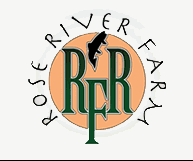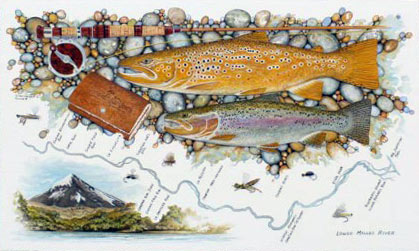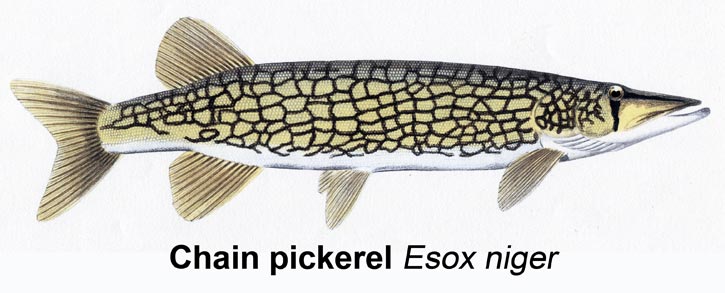Chain Pickerel, June 2013, Fish of the Month!
Chain Pickerel
Esox Niger
Local Names:
River pike, Grass pike, Jack, Jackfish, Eastern pickerel, Black chain pike, Mud pickerel, Green pike
Average Size:
14 to 24 inches
1 to 3 ½ pounds
Distinguishing Field Marks:
Color and color pattern are reliable distinguishing field marks for this species. (See the illustration.)
-
The distinct dark chain-like pattern on the sides, gill covers, and cheeks is usually prominent in adults.
-
The cheeks and gill covers are completely scaled."
-
The snout and lower jaws are very long, although the upper jaw does not extend beyond the mid-point of the eye. There is a nearly vertical dark band extending downward from the bottom of the eye, and a horizontal dark band extending forward from the front of the eye.
-
The bottom of the lower jaws usually have 8 sensory pores on each side.

-
The lower jaw extends beyond the upper.
-
There are no markings on the fins.
-
The tail fin is deeply forked.
North American Range:
Map to the right shows approximate range in North America.
Diet:
Newly-hatched Chain pickerel feed on plankton, aquatic insects, and other invertebrates. This continues until they are from 4 to 6 inches in length when they begin taking a variety of small fish. As adults, Chain pickerel feed mainly on whatever fish are available but supplement that with frogs, crayfish, snakes, mice, and other small mammals that happen their way.
Biology:
Chain pickerel, true to Pike family tradition, spawn in the spring, usually at water temperatures around 45 to 50 degrees F. Like their larger relatives, Chain pickerel enter shallow flooded margins of lakes, ponds, and streams at the beginning of the spawning season. Spawning takes place in the daytime, and continues over a period of a day or two. Each female carries 6,000 to 8,000 eggs.
The parents do not care for the fertilized eggs and move out of the shallowest spawning areas almost immediately after spawning to resume feeding. The eggs incubate in the emergent vegetation for a period of 6 to 12 days. Upon hatching, the young fish are nearly dormant and attach themselves to weeds by an adhesive patch on their snouts. There they subsist on the contents of their yolk sacks for several more days, after which they become free swimming and begin actively feeding.
As with all members of the Pike family, females grow faster, live longer, and achieve greater size than males.
Locating and Fly Fishing for Chain Pickerel:
True to Pike family form, Chain pickerel favor warm, shallow water vegetation and bottom structure-rich habitats. They are most often associated with rooted aquatic weed beds, such as the aptly named Pickerel weed. In the warmest summer weather Chain pickerel may move into slightly deeper water along drop offs.
Fly fishing for Chain pickerel can be lots of fun, especially for youngsters who are practicing to improve their fly-fishing skills. Large (say size 2 or 4) streamer flies or surface bugs are standard choices for these fish. All the common Largemouth bass fly patterns are good choices for pickerel fishing, and they tend to be very un-selective. If you tie your own flies, you might want to avoid tying any body on your streamers, as, like all the Pikes, pickerel have many very sharp teeth that will quickly cut through pretty much any fly-body material. This is also good advice because, in favorable habitats, these fish can be very plentiful and you'll want to use a fly for more than one fish. Because these fish are lovers of weed and lily beds, weed guards are also recommended. They're not likely to tooth-cut 10 lb. test leader, but could easily do so with 4 or 6 lb. test.
You might think of Chain pickerel as miniature Northern pike. Their habitat preferences and their habit of lying motionless as they await passing prey, are nearly identical to those of their larger cousins. In most still water pickerel habitats, a float-tube, canoe, or boat is necessary to get close to their prime locations. When you get there, move slowly along the weed-beds' edges casting to likely-looking spots. Let the fly or bug settle and then begin its retrieve, stripping it back in foot-long spurts. These fish will move considerable distances at high speed, making a visible bulge on the water's surface, as they charge. Usually it won't take long to find Chain pickerel when you're in their preferred haunts, and watching them rush to engulf your fly can provide hours of fly-fishing fun.
When you have a fish to hand, do not use your fingers to un-hook it, their needle sharp teeth will cut you. Pliers are the easiest solution to the pickerel un-hooking problem….
Significance to Humans:
Too small to ever have been of significant commercial interest, the Chain pickerel has long been consumed by those anglers who catch it. Although, as with all fish, its flavor varies according to the water from which it's been taken, when carefully prepared (skinned) the Chain pickerel's flesh is generally of a good "sweet" flavor, but is quite bony.
Status:
Maintaining, in favorable habitats, often in very large numbers, through natural reproduction.







